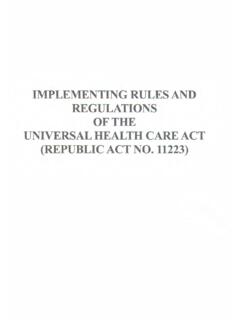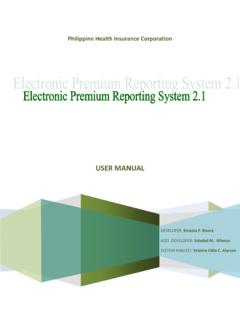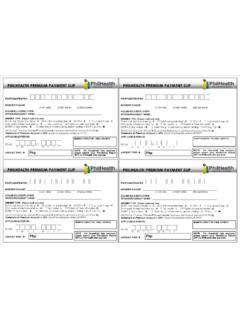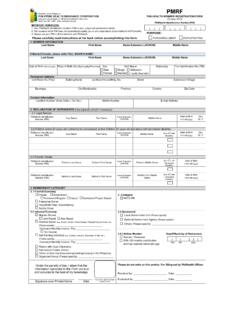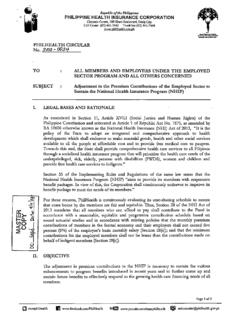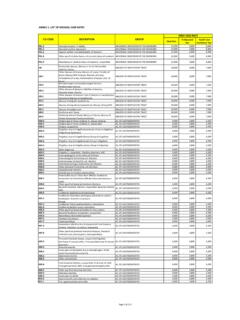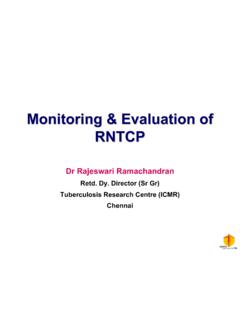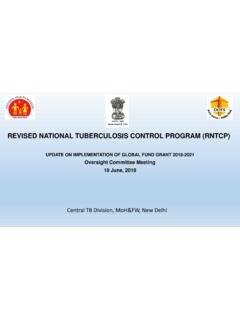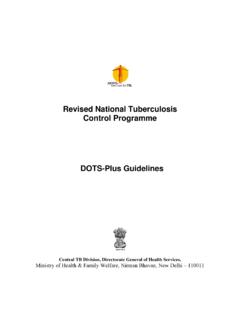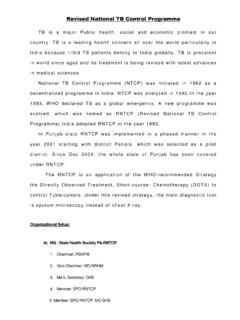Transcription of COMPREHENSIVE AND UNIFIED POLICY FOR TB CONTROL IN …
1 COMPREHENSIVE AND UNIFIED POLICY FOR TB CONTROL IN THE PHILIPPINES Department of Health Government of the Philippines In collaboration with the Philippine Coalition Against tuberculosis March 2003 TABLE OF CONTENTS I. Executive Summary II. NTP Core Policies III. Guidelines for Implementation by Private Physicians and Health Facilities IV. Guidelines for Implementation by Government Agencies V. SSS / GSIS / ECC TB Benefits POLICY VI. PHIC TB Package EXECUTIVE SUMMARY tuberculosis has been a major cause of illness and death in the Philippines yet TB CONTROL efforts have historically, been fragmented and uncoordinated. The national TB CONTROL Program of the Department of Health has made significant advances in improving the quality and extent of its CONTROL efforts but the private sector and even other departments of government have not been integrated into the overall TB CONTROL activities.
2 Recognizing the need for a more UNIFIED and concerted effort the Department of Health, assisted by the Philippine Coalition Against tuberculosis organized various stakeholders into a working group to develop this COMPREHENSIVE and Integrated POLICY for TB CONTROL in the Philippines. Beginning in January 2002, the organizing committee began a series of stakeholders meetings and on World TB Day, March 2002, a Memorandum of Agreement in which each stakeholder committed their support and involvement in the POLICY development process was signed. Using the national tuberculosis Program (NTP) as the core POLICY , two main working groups were formed. The first group was to develop the guidelines for the implementation of the NTP in government agencies other than the Department of Health.
3 This group included the Departments of Health, Education, national Defense, Interior and Local Governments, Justice, Agriculture, Agrarian Reform, Social Welfare and Development, Science and Technology, the national Economic Development Authority, Philippine Information Agency and the national Council for Indigenous Peoples. The second group was tasked with establishing policies that would formalize the involvement of the private sector, particularly private physicians, in TB CONTROL . This group was comprised of the representatives of the Social Security System, Government Services Insurance System, Employees Compensation Commission, the Philippine Health Insurance Corporation, the Philippine Medical Association, Association of Health Maintenance Organizations of the Philippines, Employees Confederation of the Philippines, Trade Union Congress of the Philippines, Occupational Safety and Health Center (DOLE) and the Overseas Workers and Welfare Administration.
4 This resulting POLICY presents several significant achievements. First, the Guidelines for Implementation by Government Agencies formalizes and operationalizes the collaboration between the Department of Health and other departments of government with regards to the NTP. Second, the Guidelines for Implementation by Private Physicians will provide clear directions on the clinical management of TB by private practitioners that will comply with NTP POLICY . The TB Benefits POLICY of the SSS/GSIS/ECC has UNIFIED the policies of these different agencies and aligned them with the NTP. The pioneer TB outpatient benefits package of the Philippine Health Insurance Corporation is presented for the first time in this POLICY .
5 The organizing committee concludes with three recommendations: 1) that a final meeting be held before the end of 2002 to formally obtain the official commitments of each stakeholder in the acceptance and implementation of the POLICY , 2) that a one-year grace period for dissemination and training regarding the POLICY beginning August 22, 2002, be implemented prior to full implementation in August 2003, and 3) that the organizing committee and all stakeholders be reconvened after two full years of implementation to evaluate the POLICY and recommend any necessary revisions. DEPARTMENT OF HEALTH, REPUBLIC OF THE PHILIPPINES FOR THE national tuberculosis CONTROLPROGRAM, 2001 FOREWORD For decades, tuberculosis has been causing enormous socio-economic losses to our country.
6 Hence, controlling it to a level where it is no longer a public health problem is a priority under the Health Sector Agenda. Consequently, this will significantly contribute to the poverty reduction efforts of the government. TB CONTROL depends largely on the capacity of various health care facilities to administer the TB management based on technically sound, evidence-based and consistent policies and procedures. Adopting standardized TB management protocols and guidelines facilitates effective program implementation in all parts of the country. The Manual of Procedures (MOP) for the national TB CONTROL Program (NTP) contains guidelines on how to diagnose, treat and counsel TB patients.
7 It further describes how the Tb CONTROL program should be managed to enable us to attain our program targets in the context of devolution. This manual will be helpful to program managers and coordinators, health workers at our public and private health facilities, training officers and other individuals and organizations. The major trigger points for the revision of the 1988 MOP was the 1993 external review of NTP and the adoption of the Directly Observed Treatment Short Course (DOTS) strategy by the international community to reverse the TB epidemic. This manual is a product of partnership among the Department of Health (DOH), local government units and international agencies.
8 It has a long gestation period. Piloting of these guidelines started during the DOH project assisted by the Japanese International Cooperation Agency (JICA) in Cebu in 1994 and expanded to other areas adopting the DOTS strategy. The World Health Organization Western Pacific Regional Office, extended technical assistance to ensure that the guidelines are consistent with technically sound and internationally accepted policies. This manual consolidates all the findings, experiences and lessons learned from the Tb CONTROL projects which were assisted by our international partners like WHO, JICA, World Vision-CIDA, UHNP-World Bank, USAID, AusAID, Medicos del Mundo and ADB.
9 The former Staff of the TB CONTROL Service DOH, steered it through the process of technical reviews and consultations to ensure that NTP guidelines are uniform, attuned with the current trends, acceptable to the health workers and operationally feasible. However, in view of the fast changing technology and systems, we anticipate that there will be changes later. Thus, we welcome comments and recommendations to sustain the MOP s relevance and appropriateness. We hope that this Manual will be a tool to unify our efforts and attain our vision of TB-free Philippines. MANUEL M. DAYRIT, MD, MSc Secretary of Health Notes on Manual of Procedures (MOP) for the national tuberculosis CONTROL Program, 2001 Philippines The national tuberculosis CONTROL Program (NTP) in the Philippines was initiated in 1968 and integrated into the general health service based on World Health Organization (WHO) POLICY .
10 The first NTP Manual of Procedures (MOP) was developed in 1988. In 1994, the NTP Guidelines was revised by the Department of Health (DOH) in collaboration with DOH-JICA Public Health Development Project and WHO Western Pacific Regional Health Office (WPRO) based on the recommendations of WHO, which conducted an external evaluation of the implementation of the Philippine NTP in 1993. The Revised NTP Guidelines was first introduced by the DOH-JICA Public Health Development Project in Cebu province. Accordingly, the DOH adapted the Revised NTP Guidelines for nationwide implementation after its feasibility and effectiveness was proven. This Manual of Procedures was developed based on the Revised NTP Guidelines to be consistent with current health situation in the Philippines.
